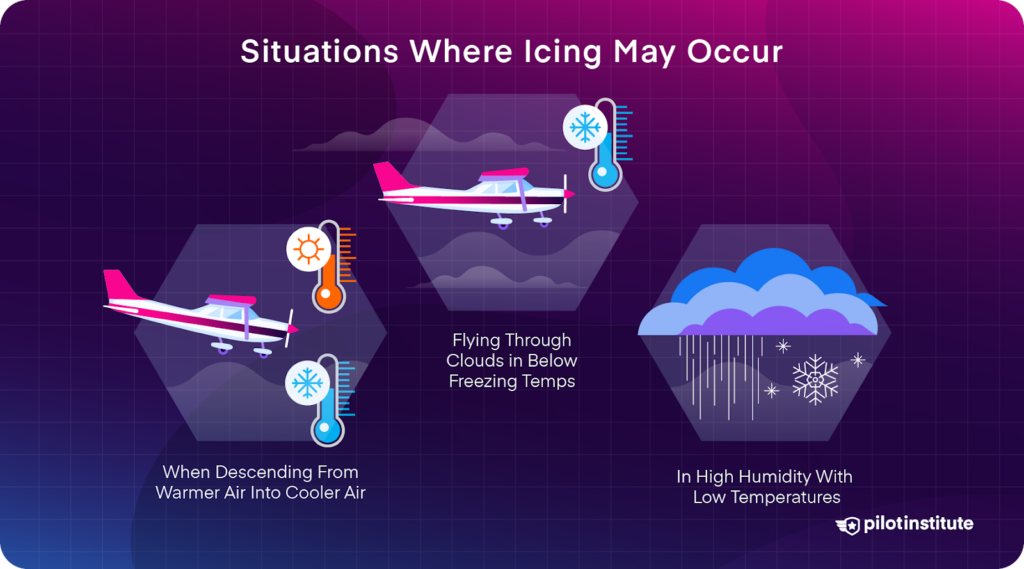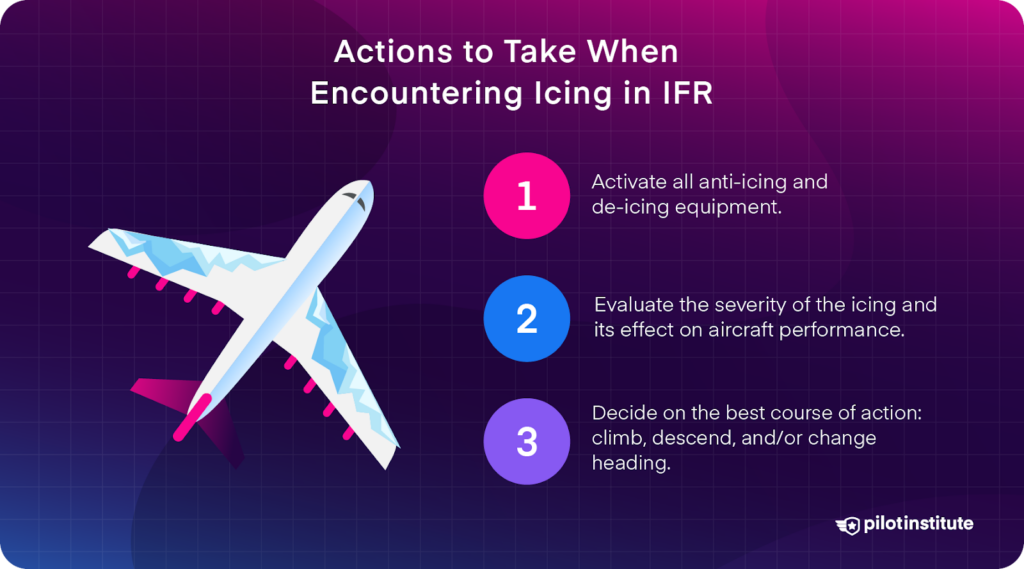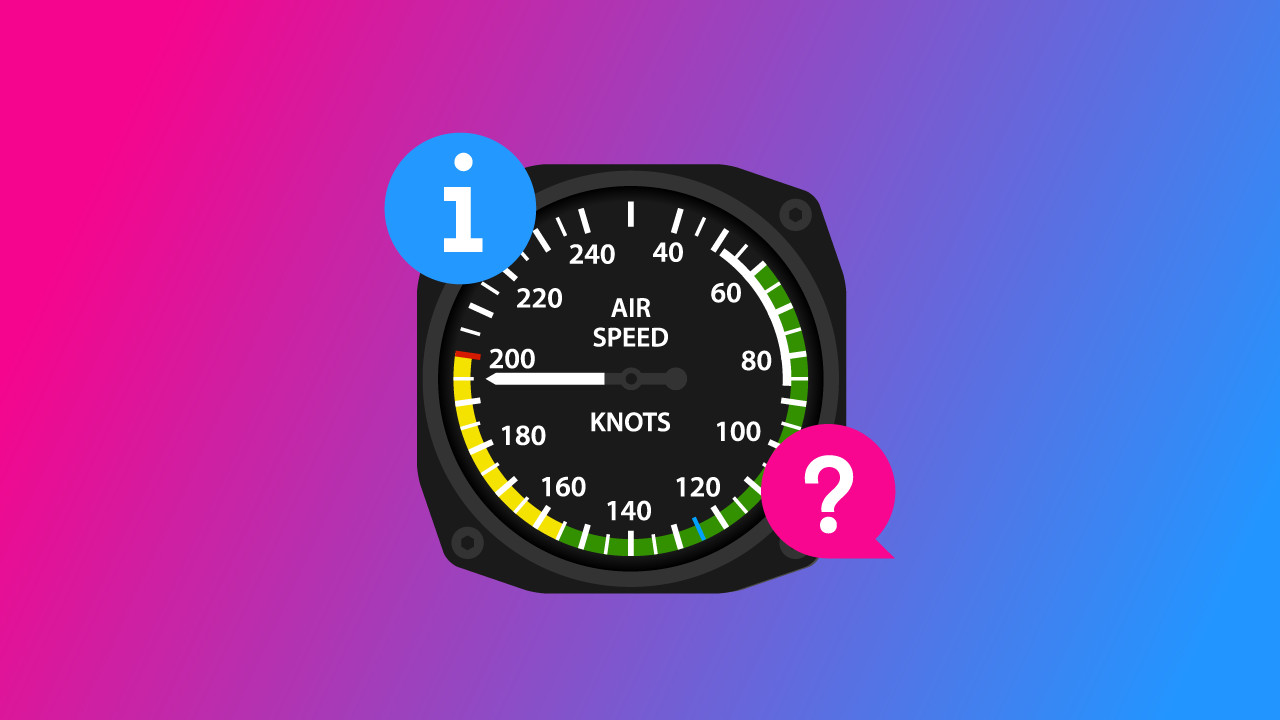-
Key Takeaways
-
Understanding Icing Conditions in IFR
- Icing Can Happen Year-Round
-
Recognizing Icing in IFR Flights
-
Actions to Take When Encountering Icing in IFR
- Climb, Descend, or Change Heading
- Autopilot During Icing
- Stay in Touch With ATC
-
De-Icing Solutions and Equipment
- How To Deal with Ice
- Before Takeoff Icing Procedures
- Aircraft Anti-Icing Equipment
- Use Good Judgment
-
Conclusion
If you’re flying IFR in winter weather, icing is a threat you have to actively prepare for.
And ice doesn’t just build on your wings; it can sneak up on you quickly. It can freeze your sensors and affect how well your aircraft performs.
But the good news is that icing is predictable if you know what to look for. If you can understand the conditions that lead to icing and know how to react when it happens, you’ll keep yourself ahead of the harsh weather.
In this article, you’ll learn how to recognize icing before it becomes a problem and what steps to take if you encounter it during a flight.
Key Takeaways
- Understanding icing conditions will enable you to safely fly IFR in winter weather.
- Recognizing early signs of ice accumulation can prevent dangerous situations.
- Taking quick action and using anti-icing equipment is recommended to counter icing.
- Thorough pre-flight planning and continuous weather monitoring help mitigate icing risks.
Understanding Icing Conditions in IFR

Icing refers to the buildup of ice on aircraft surfaces while in flight. This can significantly change an aircraft’s aerodynamics, potentially resulting in a loss of control. For IFR pilots, being aware of icing conditions is important for maintaining safety during winter operations.
Common situations where you may face icing on IFR flights include:
- Flying through clouds or precipitation when temperatures are around or below freezing.
- Descending through a temperature inversion layer (warmer air that sits on top of a layer of cooler air).
- Operating in regions with high humidity and low temperatures.
A combination of temperature, altitude, and moisture leads to ice formation. Icing usually happens when flying through visible moisture (like clouds or precipitation) at temperatures ranging from 0°C to -20°C (32°F to -4°F). However, supercooled large droplets (SLD) can create ice even at lower temperatures.
Icing Can Happen Year-Round
So when can it happen?
Icing can occur not just in winter or polar areas. Given the right conditions, it can happen throughout the year, particularly at higher altitudes. As a pilot, you must remain alert, no matter the season.
The FAA classifies icing intensity as:
- Trace
- Light
- Moderate
- Severe
Each category carries increasing risks to aircraft performance and safety. Knowing these classifications will allow you to make well-informed decisions when flight planning and while in the air.
Recognizing Icing in IFR Flights

Early detection of ice accumulation is necessary for safe IFR flight operations. You should constantly observe visual and instrument-based signs for icing conditions.
The indicators of ice accumulation on an aircraft include:
- Visible ice on windshields, wings, or probes.
- Reduced airspeed or climb performance.
- Increased fuel flow to sustain airspeed.
- Unusual vibrations or control forces.
Detecting icing visually can be difficult in IFR conditions, particularly at night. You should frequently check the aircraft’s surfaces that are visible from the cockpit, such as windshield wipers, wing leading edges, or propeller spinners. Any ice on these surfaces indicates icing conditions.
Instruments onboard can assist you with detecting icing. Most modern aircraft have ice detection systems that will notify you. The following instruments provide useful information on icing:
- Outside Air Temperature (OAT) gauge.
- Pitot heat ammeter (starts drawing more current).
- Stall warning systems (which may activate sooner due to altered wing aerodynamics).
Maintaining situational awareness is the best method for identifying potential icing conditions. That’s why you should:
- Keep an eye on weather reports and forecasts throughout the flight.
- Pay attention to PIREPs (Pilot Reports) that mention icing.
- Be mindful of cloud types and temperatures that cause icing.
- Listen to Air Traffic Control (ATC) advisories about icing conditions.
Remember that icing can develop quickly and without warning. Always use caution when flying in icing conditions. Ongoing monitoring and a proactive icing detection approach can improve the safety of your IFR flight operations.
Actions to Take When Encountering Icing in IFR

When faced with icing conditions during an IFR flight, you must act right away. The main objective is to exit the icing conditions as soon as possible while maintaining control of your aircraft.
You can take the following actions:
- Activate all anti-icing and de-icing equipment.
- Evaluate the severity of the icing and its effect on aircraft performance.
- Decide on the best course of action: climb, descend, and/or change heading.
Climb, Descend, or Change Heading
Climbing can be a useful strategy if the icing layer is thin and clear air is available above. However, you need to gauge if the aircraft can safely climb with the ice it has accumulated.
Otherwise, you should consider descending if weather reports indicate warmer air below (which aids in melting ice). This approach can be particularly effective when flying through a temperature inversion layer. Still, you need to be mindful of terrain and minimum safe altitudes when considering this choice.
Sometimes, simply changing the heading to exit the icing conditions can also work, especially when encountering localized icing or icing linked to certain cloud formations.
Tip: In most cases, you should follow the 3000-foot altitude rule–either climb or descend 3000 feet to clear icing conditions.
Autopilot During Icing
Using autopilot in icing situations is a common topic of discussion among pilots. While autopilot can help maintain steady flight and lessen your workload, it might hide subtle changes in how the aircraft handles due to ice buildup.
Many experts suggest:
- Using autopilot at first to keep a stable flight while evaluating the situation.
- Occasionally disengaging autopilot to manually fly the aircraft and gauge control responses.
- Being ready to take control if autopilot performance declines.
Stay in Touch With ATC
Communication with ATC is essential when dealing with icing. You should:
- Notify ATC about the icing encounter and ask for options for altitude or route changes.
- Declare an emergency if the situation worsens.
- Provide PIREPs to assist other pilots and enhance weather forecasting.
ATC can offer valuable support by:
- Suggesting alternate routes to fly clear of icing areas.
- Coordinating altitude changes to locate ice-free levels.
- Providing vectors to the destination.
Note: ATC might not always be aware of specific localized icing conditions. If required, you should request new vectors and provide ATC with icing alerts.
De-Icing Solutions and Equipment

Nowadays, aircraft come equipped with various systems designed to address in-flight icing. You must understand these systems and how to use them correctly for safe IFR operations in the winter.
How To Deal with Ice
Onboard de-icing systems generally consist of:
- De-icing boots located on the leading edges of the wings and tail.
- Heated pitot tubes and static ports.
- Electrically heated propellers.
- Heated windshields.
Anti-icing systems, which prevent ice formation, may include:
- Engine intake heating systems.
- Thermal anti-ice heaters for the wing and tail leading edge.
- Bleed air systems for windshield anti-icing.
Before flying, you should be well-acquainted with the operation of these systems specific to your aircraft. Most importantly, you need to activate anti-icing systems before entering known icing conditions and engage de-icing systems as soon as ice accumulates.
Before Takeoff Icing Procedures
Don’t ignore pre-flight de-icing procedures on the ground/before takeoff. These procedures may involve:
- Removing all frost, ice, or snow from the aircraft’s surfaces.
- Applying de-icing fluids to prevent ice formation before takeoff.
- Conducting a pre-flight inspection to check all surfaces are clear of ice.
You should be mindful of the holdover times for de-icing fluids and takeoff within this timeframe or request additional de-icing if required.
Aircraft Anti-Icing Equipment
During flight, using your aircraft’s anti-icing features can help. This includes:
- Monitoring ice accumulation and the effectiveness of the systems.
- Cycling de-icing boots at intervals is recommended by the manufacturer.
- Maintaining proper power settings when using engine anti-ice.
- Utilizing windshield heat and wipers as necessary for visibility.
Use Good Judgment
It’s important to remember that while aircraft systems and equipment can assist in managing icing, they do not replace the need to avoid flying in icing situations. You should always prioritize exiting icing conditions rather than relying solely on de-icing and anti-icing equipment.
Conclusion
Flying in icing conditions while on an IFR plan isn’t something you can just ignore or shrug off. You’ve got to be prepared, think ahead, and react the moment you notice ice buildup.
You might have to respond by climbing to a colder altitude where supercooled droplets can’t form. In some cases, you might need to descend into warmer air to melt that ice away. Either way, your response needs to be quick.
Understanding the weather, combined with smart pre-flight planning, will keep you safe.
Rely on all the tools at your disposal, including real-time reports from other pilots and the latest icing forecasts.
Icing doesn’t have to be a flight-ender, the more you practice and plan, the better you’ll get at staying one step ahead of it.



